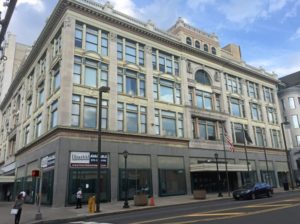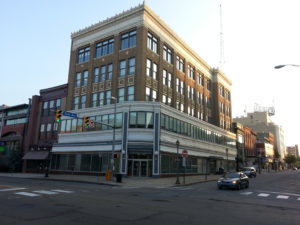By David Falchek / STAFF WRITER / Published: October 31, 2016
Two landmark downtown Scranton buildings hit the real estate market after a foreclosure and sheriff’s sale failed to draw any bidders.
An air of uncertainty — but also opportunity — hangs around the Samter’s and Oppenheim buildings, department stores in Scranton’s heyday, on Lackawanna Avenue.
The former Oppenheim building, and attached Lewis & Reilly building, with a combined square footage of 193,000, is listed at $2.9 million, working out to about $15 per square foot. The Samter’s building, with 43,712 square feet, has an asking price of $500,000, or $11.44 per square foot.
At the sheriff’s sale earlier this month, the foreclosing lender, NBT Bank, failed to get back the money it was owed: $3.2 million on Oppenheim and $600,000 on Samter’s.
NBT Bank foreclosed on the former Oppenheim building at Lackawanna and Wyoming avenues and the former Samters building at Lackawanna and Penn avenues after owners Scranton Mall Associates, a firm owned by the Boscov family, defaulted on its mortgage.
It is the second foreclosure of major Boscov properties in Scranton in the past two years. A 2014 foreclosure of the former Mall at Steamtown resulted in its sale during an auction last year to Roaring Brook Twp. real estate developer John Basalyga, who renamed it the Marketplace at Steamtown.
Potential buyers, it seemed, thought the price of the former Oppenheim and Samters buildings was too much. Now, by actively marketing the buildings, the bank, eager not be landlords, reduced the prices. Offers have been coming in on both properties, said John Cognetti, of Hinerfeld Commercial Real Estate, listing agent. After one more marketing push with the hopes of getting some more interest, the bank will select an offer with an eye to closing by year’s end, he said.
Bob Durkin, president of the Greater Scranton Chamber of Commerce, said he talked with some developers interested in the properties, although he declined to identify them.
“Samters is just not in good shape, not set up well for offices, and will require a lot of work no matter what,” he said. “If someone does that, they still have Class C office space in an area where we have a lot of Class C space, and no dedicated parking.”
Opportunities
 Oppenheim, which has solid tenants, has potential for mixed uses, Mr. Durkin said, such as offices or maybe retail and apartments.
Oppenheim, which has solid tenants, has potential for mixed uses, Mr. Durkin said, such as offices or maybe retail and apartments.
However, Oppenheim, with its state and federal government tenants, is a more complicated deal, Mr. Cognetti said. Residential may not be the best option for the Oppenheim portion of the building, much of which was updated for office space. Vast interior spaces in the Oppenheim make it challenging to lay out apartments with windows.
However, Mr. Cognetti said it is possible the Lewis & Reilly portion could be apartments, and the connected Oppenheim remain offices, providing a live-work opportunity in a single building.
“We see what is happening in Scranton and around the country, and millenials and older couples want to live downtown where they will be near activity and services,” Mr. Cognetti said.
No matter who buys what, they will have their work cut out for them, he said. While the buildings may seem like relative deals, investors know that buying the property is the start of their investment.
Commercial real estate investors are looking at the purchase price and carrying cost of property, the cash flow from existing tenants, and the prospects for cash flow in the future.
Real estate agents often say the true value of any property is the amount someone is willing to pay for it, and asking prices and sale prices are not always comparable.
 For example, the vacant, 255,964-square-foot Globe Store on Wyoming Avenue sold to Lackawanna County government for $1.3 million, which works out to about $5.08 per square foot. The slim, 11-story Scranton National Bank Plaza, 100-108 North Washington Ave., is on the market for $1.1 million. However, considering SNB has not sold in more than a year, it likely is priced too high, at about $26.21 per square foot. It does have the advantage of being mostly rented with an anchor tenant and occupants upstairs — translating into a steady revenue stream.
For example, the vacant, 255,964-square-foot Globe Store on Wyoming Avenue sold to Lackawanna County government for $1.3 million, which works out to about $5.08 per square foot. The slim, 11-story Scranton National Bank Plaza, 100-108 North Washington Ave., is on the market for $1.1 million. However, considering SNB has not sold in more than a year, it likely is priced too high, at about $26.21 per square foot. It does have the advantage of being mostly rented with an anchor tenant and occupants upstairs — translating into a steady revenue stream.
Massive buildings tend to sell at a discount, Mr. Cognetti said. The Globe and Oppenheim may not have as broad a range of new uses, though.
“A smaller commercial property is easier to deal with and easier to fill,” he said.
Earlier this year, a retail property on Commerce Boulevard that houses a Sleepy’s mattress shop sold in excess of $4 million. However, the single-tenant building sits in a high-traffic retail corridor on real estate likely to retain its value. The tenants may be locked in for a while or the buyer, a national real estate investment trust, may have other quality tenants in the wings.
“Appraisers look at the past; investors look to the future,” said Daniel Naylor, a commercial real estate agent with Mericle Commercial Real Estate in Wilkes-Barre. “For some buildings you also factor in rehabilitation, marketing and maintenance costs, and figure that into the price so you know your anticipated return.”
Buyers want to be able to cover their own capital costs, their mortgage, immediately or very soon, he said.
The buyer of the Samters building would be looking at a long time and lots of money before collecting a single rent check, he said. The new owner would have to be willing to carry that property, with no return, for several months while pouring money into a conversion, Mr. Naylor said.
“For those reasons, not many investors are going to be interested in a vacant building,” Mr. Naylor said. “The exception may be if the buyer will be the user, or buyers who have a definitive plan.”
One active investor and developer who may have a plan is Mr. Basalyga, as he continues to repopulate the Marketplace at Steamtown. He talked about his vision for the entire Lackawanna Avenue corridor, but he has not definitively said whether he would make an offer on the Oppenheim or Samters buildings. He noted an interest in developing residential real estate in his company’s purchase of the Electric City Parking Garage for a $1 from the Scranton Parking Authority as part of the city’s parking monetization deal in the summer. The deal included 60 parking spaces for “future residential development.” In Mr. Basalyga’s portfolio, he successfully converted a number of the industrial properties to apartments.
Office glut
Add to that an existing glut of vacant office space in downtown Scranton — which will worsen once the county consolidates offices from private buildings to the former Globe Store building.
Mr. Naylor, who has no connection to the properties in Scranton, said commercial real estate buyers acquire income stream, rather than real estate. So Mr. Naylor would consider the current tenants, the terms of those existing leases, and the prospects for filling vacancies, future anticipated demand for the space and the likelihood that the investor could increase those rents to capture value from future demand.
Existing tenants is one reason why the mostly rented SNB Plaza is angling for a relatively higher price and why Oppenheim is priced higher on a square-foot basis than the empty Samters building, which Mr. Cognetti said has only the most basic features.
“This could be great things for the downtown,” Mr. Cognetti said. “The development of Samters would obviously bring new life to that corner and compliment what is happening around it. At one time, the intersection of Wyoming and Lackawanna was the prime corner, and whatever is next for Oppenheim would re-energize that building.”
Contact the writer:
dfalchek@timesshamrock.com





